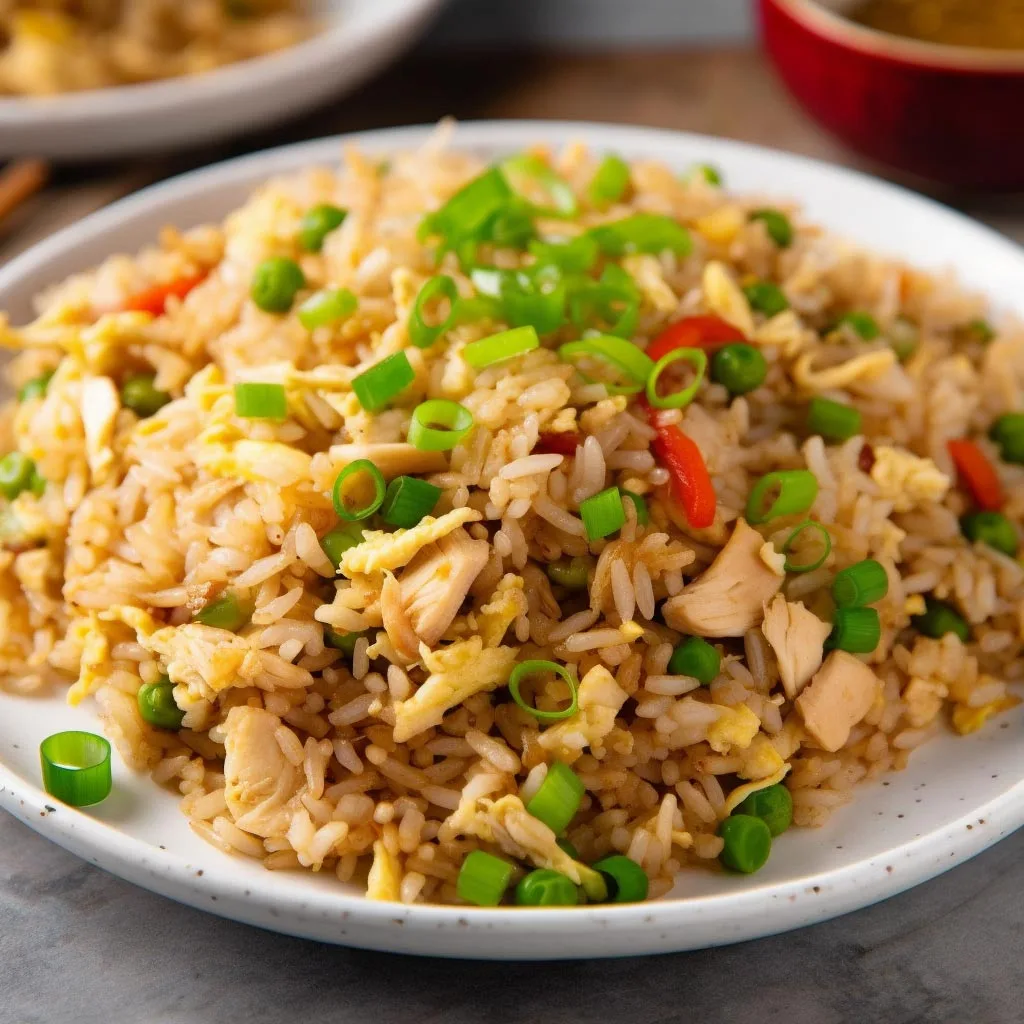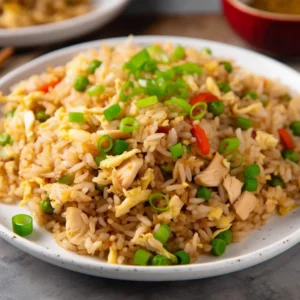
Chicken fried rice is a staple dish in many cuisines, particularly in Asian cooking, where its versatility and simplicity have made it a beloved meal across generations. Originating from China, this dish has evolved and adapted, taking on unique flavours and ingredients in different parts of the world.
At its core, chicken fried rice is about balance and harmony in cooking. Its preparation isn’t complicated, making it a great option for those starting their culinary journey.
The process involves stir-frying rice with a mix of chicken, vegetables, and a variety of seasonings to create a meal that is both nutritious and full of flavour.
There are numerous variations of this recipe, each reflecting the culinary traditions of the region it comes from.
Some versions include the addition of different meats like shrimp, while others focus on a vegetarian approach, incorporating a wider array of vegetables. The beauty of chicken fried rice lies in its adaptability; it’s a dish that encourages experimentation and personalisation.
The recipe’s history is as rich as its flavour profile. It’s believed to have originated in China as a way to avoid wasting leftover rice. Over time, it transformed from a simple, economical meal into a canvas for culinary artistry, showcasing the creativity and skill of the cook.
A key aspect of making perfect chicken fried rice is getting the rice right. It should be cooked until just tender, avoiding overcooking which can lead to mushy fried rice.
The lightly beaten eggs are scrambled and mixed with the rice, offering a creamy texture and richness.
This dish is also an excellent way to incorporate leftover rice and chicken, making it a practical and economical choice for a meal. The final touch of soy sauce brings everything together, adding a depth of flavour that is quintessentially Asian.
Whether you’re a beginner or a seasoned cook, this recipe offers a delightful experience that’s sure to become a regular in your cooking repertoire.
Expert Tip: When cooking chicken fried rice, use high heat to get that authentic stir-fry flavour. High heat cooks the ingredients quickly and helps them retain their texture and nutrients.
Basmati rice: Basmati rice is a fantastic choice for chicken fried rice due to its long, slender grains that cook up light and fluffy. This type of rice doesn’t clump together as much as shorter grains, making it ideal for stir-frying. It absorbs the flavours of the soy sauce and other ingredients beautifully, providing a perfect base for the dish.
If you don’t have basmati rice, jasmine rice is a great alternative, offering a similar texture and a slightly different, but equally delightful, aroma.
Boneless, skinless chicken breast: Chicken breast is lean, cooks quickly, and pairs wonderfully with the various flavours in this recipe.
Its mild taste allows the other ingredients, like the garlic and soy sauce, to shine through, while providing a satisfying source of protein. If you prefer, you can substitute the chicken breast with thigh meat for a juicier texture, or even tofu for a vegetarian version.
Vegetable Oil: Vegetable oil is used for its high smoke point, making it suitable for the high-heat stir-frying required in this recipe. It doesn’t overpower the other flavours, ensuring a balanced taste. For a healthier option, you can use olive oil, though it may slightly alter the flavour profile.
Onion: Onion adds a depth of flavour and a subtle sweetness when cooked. It’s a key aromatic that forms the base flavour of many dishes, including chicken fried rice. If onions aren’t your favourite, you can use shallots for a milder taste.
Garlic cloves: Garlic is essential for its pungent, earthy flavour, which enhances the overall taste of the dish. It brings a warmth and complexity that’s hard to replicate with other ingredients. If fresh garlic isn’t available, garlic powder can be used as a substitute, although the taste might be slightly different.
Carrots: Carrots add a pop of colour, a hint of sweetness, and a crunchy texture to the fried rice. They also contribute beneficial nutrients and fibre. If you’re not a fan of carrots, consider using bell peppers or broccoli for a similar crunch.
Frozen peas: Peas bring a fresh, sweet contrast to the savoury elements of the dish. They cook quickly and are a convenient way to add vegetables to your meal. Green beans or corn can be used as an alternative if peas aren’t available or preferred.
Eggs: Eggs add richness and a creamy texture to the fried rice. They blend seamlessly with the other ingredients, offering a contrast in texture and flavour. For those who don’t eat eggs, scrambled tofu can be a good substitute.
Soy sauce: Soy sauce is key for its salty, umami flavour. It ties all the components of the dish together and creates that distinctive Asian taste. If you need a gluten-free option, tamari is a good substitute.
Salt and pepper: These seasonings are used to enhance the natural flavours of the other ingredients. They’re staples in most kitchens and can be adjusted according to personal taste.
Fresh coriander: Coriander adds a fresh, citrusy note to the dish. It’s an optional garnish that brings a burst of colour and a hint of freshness. If you’re not a fan of coriander, you can leave it out or replace it with parsley or green onions for a similar effect.
Expert Tip: Don’t shy away from experimenting with seasonings in your chicken fried rice. A dash of sesame oil or a sprinkle of chilli flakes can add an extra layer of flavour to elevate the dish.
Absolutely! In fact, using leftover rice can often yield better results in fried rice recipes. Leftover rice is drier, which helps it fry better and not turn mushy. Just make sure the rice was stored properly in the fridge.
The key is to use a well-seasoned wok or non-stick pan and to ensure the oil is hot before adding your rice. Stirring constantly and not overcrowding the pan also helps prevent sticking.
Yes, it’s easy to turn this dish into a vegetarian delight. Replace the chicken with tofu or just increase the quantity of vegetables. You can also add different kinds of veggies like bell peppers, baby corn, or mushrooms for variety.
Chicken fried rice can be a balanced meal with protein from the chicken, carbs from the rice, and vitamins and minerals from the vegetables. Using less oil and sodium-rich sauces can make it healthier.
The best way to reheat chicken fried rice is in a pan over medium heat. Add a little water or chicken broth to keep the rice moist. Microwaving is also an option, though the texture might change slightly.
Expert Tip: To keep your fried rice from getting soggy, make sure the rice is cooked and completely cooled before using it. Chilled rice fries better and keeps its texture.
Here are some more recipes for you to enjoy! Don’t forget to leave your feedback in the comments section! I always love hearing about your experiences with my recipes, and I’m eager to know which ones become your favourites.
If you have any recipe suggestions, please do not hesitate to ask me. A great way to stay in contact with me is through Instagram, Facebook, Twitter and YouTube. Don’t forget to tag me @CookwithNabeela in your recipe photos!

Subscribe now to receive my latest recipes directly in your inbox. Stay up-to-date and never miss out!

I love to cook! I want to share with you my favourite, delicious family-friendly recipes. I want to inspire you to create fantastic food for your family every day.
Add your first comment to this post